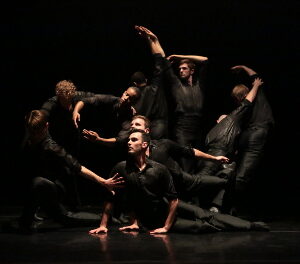Hector Berlioz thought big. Very big. Even the title of his Opus 5 could not be simply Requiem; it had to be Grand Messe des Morts (Grand Mass for the Dead). It is a work which we rarely hear in live performances simply because the number of performers required is so large as to be beyond the budget of most musical organizations. As enumerated in the superb program notes by Joseph and Elizabeth Kahn, Berlioz listed the performers required as follows:
- Strings: 25 violins I, 25 violins II, 20 violas, 20 ‘cellos, and 18 basses
- Woodwinds: 4 flutes, 2 English horns, 4 clarinets, and 8 bassoons
- Brass: 12 horns, 4 cornets, 12 trombones, and 4 tubas, plus an additional four brass ensembles requiring some 20 more players
- Percussion: 16 timpani, 2 bass drums, 10 pairs of cymbals, and 4 tam tams
The score called for 210 singers plus a tenor soloist, but Berlioz specified that the chorus could be doubled or even tripled. Four hundred singers sang in the 1837 premiere.
Alfred E. Sturgis‘ North Carolina Master Chorale, comprised of c. 230, met Berlioz’ specifications. The orchestra, of course, did not, and would not have fit on the Meymandi Concert Hall stage if it had. The ensemble consisted of 37 strings, 14 woodwinds, 6 horns, 5 timpanists, and 2 percussionists, plus 18 brass players split up into the four ensembles which played from the upper tiers of the balcony (two on either side in the front, two on either side in the rear of the hall).
This disposition, of course, puts the string sections at a disadvantage: there is simply no way that 37 strings can tonally balance 24 brass players in full cry. So yes, there were times when the violins were likely audible only to those sitting in the first row or two of the hall. But this is a problem shared with small symphony orchestras: they have to have the requisite numbers of brass, woodwinds, and percussion; money left over after that determines the number of strings they will have. The question then becomes, should a work like this, or the Mahler 8th Symphony, never be performed unless one can afford the number of performers desired by the composer (and have enough space for them and their audience)? Tonight’s performance showed that a well-designed compromise can be musically and emotionally effective.
Sturgis’ conducting was clear and incisive. If there were a few juggled cutoffs or neglected phrases, those can be charged to the limited rehearsal time between conductor and ensemble. His chorus and orchestra responded with spirit and with musicianship, from the huge dramatic moments of the “Tuba mirum” to the gentle undulations of the “Quarens me” and the “Agnus Dei.” While Sturgis faithfully followed Berlioz’s score requiring long fermatas in the opening bars of the “Agnus Dei,” he didn’t take into account that those long pauses were designed with the cavernous reverberation of the Chapel of Saint-Louis des Invalides (where the Requiem was first performed) in mind. In those acoustics, the fermatas would have been filled with echoes of brass and woodwind chords. The tenors (augmented at times by some altos, since Berlioz didn’t write an alto part anywhere in this work) and basses sounded wonderful, as good or better than I’ve heard them before. Their diction could not have been improved. Their only lapse was in their intonation at the beginning of the “Agnus Dei,” where fatigue may have caused some flatting. Not to be out-sung, the sopranos and their alto helpers handled their lines with ease. Perhaps they can take diction lessons from the tenors and basses, however, as it was often hard to understand their words.
Tenor soloist Dustin Lucas, a member of the Metropolitan Opera Chorus, sang from the center of the rear balcony’s upper tier, giving a strong and excellent account of the high tessitura lines of the “Sanctus.” Being so far away from the orchestra made for occasional off-unison notes between Lucas and a flute, likely the Doppler effect in action.
At the close of the work, the string sections were finally able to take the spotlight, beautifully conjuring up the eternal light beckoned in the final prayer for the deceased.
To sum up the evening simply: The Grand Mass received a fittingly-grand performance, from the quietest a cappella passages to the heaven-storming musical portrayal of the Day of Judgment.
This was the final concert in the Master Chorale’s celebration of its seventy-fifth anniversary season. It was indeed a grand and fitting way to underscore the importance of their contribution to Raleigh’s (and North Carolina’s) artistic life. Congratulations to Sturgis and to all the singers and their supporters who make the NCMC such a significant part of this community; here’s to the next seventy-five years!











